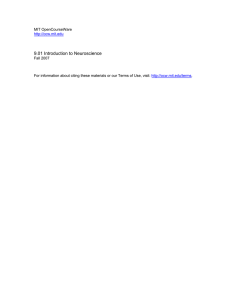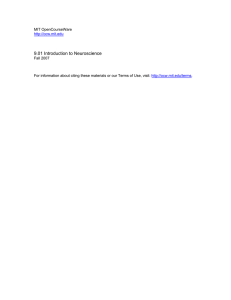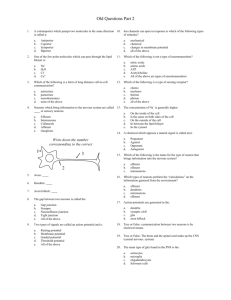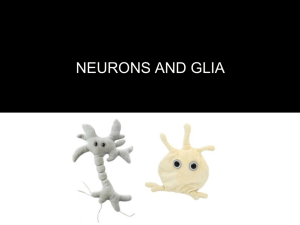9.01 Introduction to Neuroscience MIT OpenCourseWare Fall 2007
advertisement
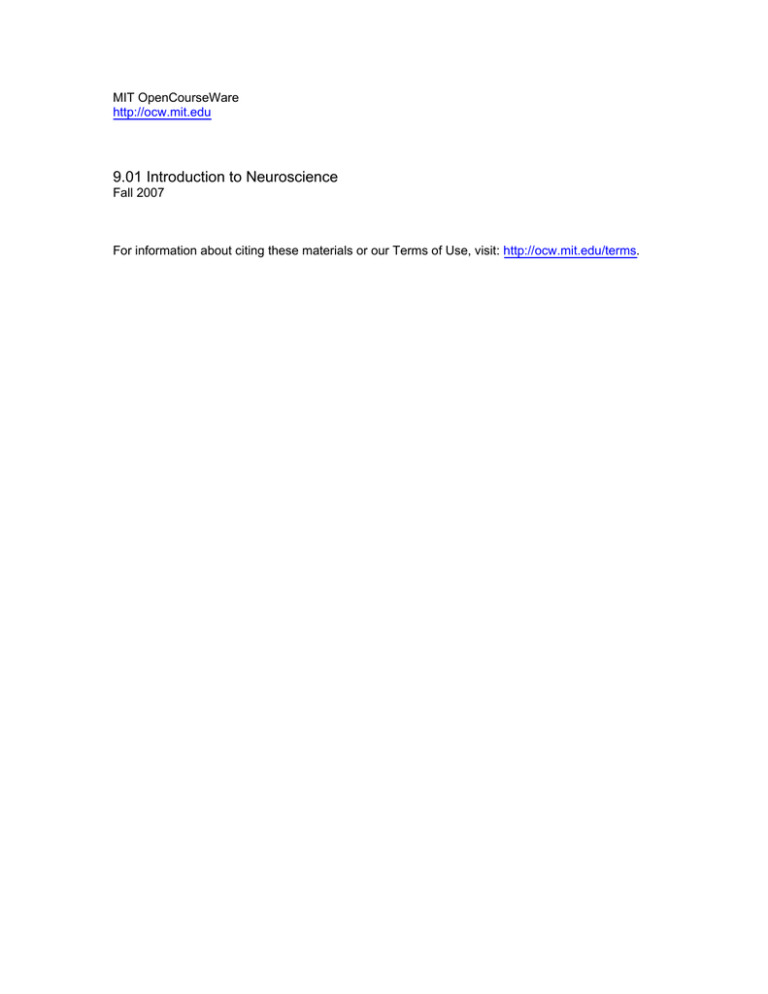
MIT OpenCourseWare http://ocw.mit.edu 9.01 Introduction to Neuroscience Fall 2007 For information about citing these materials or our Terms of Use, visit: http://ocw.mit.edu/terms. Chapter 1 Review Trepanation as cure (7000 B.C.) Egyptian writings (5000 B.C.) Heart vs. brain debate (400s B.C. Greece; Aristotle vs. Hippocrates) Ventricular localization of function (200s A.D. Rome; Galen discovered ventricles, CSF) Fluid mechanical theory (1500s; Descartes, mind separate from brain) Nerves as wires (1700s; Ben Franklin discovers electricity; Galvani, de Bois Reymond test nerves) • Bidirectional? (1810; Bell/Magendie determine ventral roots = motor; dorsal roots = sensory) Discoveries in neuroanatomy (Vesalius, etc.) • Gray matter (cell bodies) vs. white matter (axons) • CNS (brain, spinal cord, retina) vs. PNS (everything else) • Bumps (gyri) and grooves (sulci and fissures) Localization of function (1800s; experimental ablation method = destroying parts of brain to test their function; Bell/Magendie, Flourens, Fritsch/Hitzig, Ferrier; Munk) • Phrenology = correlating structure of head with personality traits (1809, Gall) • Flourens was huge critic of Gall and localization of function • Broca (1861; Broca’s Area) Evolution of nervous systems (1859; Darwin) = use of animal models Neurons (1800s, microscopy advances, cell theory) Chapter 2 Review Neurons vs. glia (10x more glia than neurons; glia insulate and support; ~100 billion neurons) Visualize the neuron = harden the brain (formaldehyde), slice it (microtome), stain • Nissl stain (all cells stained; only nucleus, membrane, rER; distinguish between neurons, glia; study cytoarchitecture) • Golgi stain (small percentage stained in entirety, can see soma and neurites) Cajal v. Golgi • Neuron Doctrine (Cajal) = neurons communicate by contact • Reticular Theory (Golgi) = neurons communicate by continuity • Final proof had to wait until development of electron microscope in the 1950s Neural anatomy (see http://www.brown.edu/Courses/BN01/images/review/neuron.pdf) • Soma = cell body = perikaryon (cytosol, organelles, cytoplasm) o Nucleus (DNA, chromosomes, genes) o Rough endoplasmic reticulum (ER with ribosomes; protein synthesis) o Ribosomes (on ER or free) vs. polyribosomes (free ribosomes attached by mRNA) o Smooth endoplasmic reticulum (variety of functions) o Golgi apparatus (sorting of proteins) o Mitochondria (site of cellular respiration; creates ATP) o Remember: DNA is transcribed Æ mRNA is translated Æ Protein • Neuronal membrane (barrier; proteins as receptors, channels, etc.) • Cytoskeleton (“internal scaffolding”) o Microtubules (longitudinally down neurites; tubulin protein braided together; MAPs) o Microfilaments (attached to membrane in neurites; fibrous like web; thin braids of actin) o Neurofilaments (intermediate size; mechanically very strong) • Neurites = axons and dendrites Axons • • • • • No rER, few free ribosomes Uniform width; travels long distances; “wires”; branches (or collaterals) at right angles Speed of action potential conduction depends on diameter (thicker = faster) and myelination Axon terminal or terminal arbor; synapse is point of contact with other cells Cytoskeleton, mitochondria Synapse (presynaptic, postsynaptic, synaptic cleft, synaptic transmission); electrical Æ chemical Æ electrical Axoplasmic transport (movement of proteins, materials up and down axons) • Remember: no ribosomes in axons; if cell bodies removed, axons would die (Wallerian degeneration) • Proteins, material enclosed in vesicles, are “walked down” microtubules • Protein “legs” = kinesin (anterograde transport, soma to axon); dynein (retrograde, axon to soma) • Process uses ATP • Retrograde transport can be exploited by scientists and viruses o Horse-radish peroxidase (used by scientists to trace connections in the brain) o Oral type of herpesvirus o Rabies virus Dendrites • Taper; short in length; “antennae” • Branches at acute angles • Of a single neuron = dendritic trees • Cytoskeleton; mitochondria • Spines; polyribosomes located under spines Æ synaptic transmission directs local protein synthesis Classifying neurons • No. of neurites (uni-, bi-, multi- polar) • Shape of dendritic tree (stellate or pyramidal, page 45) • Spiny or aspinous • Connections (sensory, interneurons, motor neurons) • Axon length (extend to other parts of brain or project locally; Golgi Type I and Type II) • Neurotransmitter (see Ch. 6) Glia • • • • Astrocytes (most numerous glia; insulation; support; regulating chem. content of extracellular space) Myelinating glia (provides myelin for axons; myelin sheath; node of Ranvier) o Oligodendroglial (CNS) o Schwann cells (PNS) Ependymal cells (lines fluid-filled ventricles of brain) Microglia (phagocytes)


